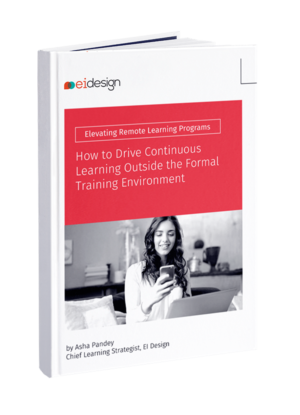A large percentage of L&D investments on training is spent on formal training. However, employees continue to learn on their own (informal learning) and they hardly turn towards formal training for learning opportunities. As a result, the gap between how employees learn and what L&D teams delivers continue to widen.
So, how can L&D teams address these challenges?
The answer lies in creating in a connected learning solution where you support formal training with informal learning opportunities.
This eBook is designed to help you in this endeavour. In this eBook, we highlight the value of informal learning and when leveraged right, how can it help address remote learners’ expectations – including, learning in the flow of work, resources that are on demand and easily accessible.
We also showcase aspects that L&D teams can use – including, how to leverage social learning, offer just-in-time learning/job aids, and what strategies they can adopt to sustain continuous learning.
eBook Overview:
Section 1 – Why Should Leaders and L&D Teams Care About Informal Learning
As corporate training departments are scrambling to deal with the implications of a remote working environment, the importance of Informal Learning is again at the forefront. This section explains why Leaders and L&D teams should invest in Informal Learning for a remote learning environment.
Section 2 – How to Encourage Informal Learning in a Remote Working Environment
This section shares strategies that will help you adopt and drive Informal Learning in today’s remote working environment.
Section 3 – How to Leverage On-demand Learning to Step Up the Application of Learning on the Job
On-demand learning applies outside the traditional structure of training courses and live classes. It consists of information and contextual objects that employees find, consume, and apply in the flow of work. This section outlines how you can leverage on-demand learning to improve learning in the flow of work and step up the application of learning on the job.
Section 4 – How to Leverage Social Learning to Support Remote Learning Programs
With smaller L&D teams under pressure to support larger groups of learners, Social Learning has emerged as a way to empower learners on a continuous learning journey. In this section, we will show you how you can leverage Social Learning for your remote learning programs.
Section 5 – How to Drive Just-in-time Learning with Performance Support Tools
Just-in-time learning should be available in the employee’s natural workflow, creating an accessible and seamless connection between job performance and learning. This section illustrates how performance support tools can help you drive just-in-time learning – particularly for your remote workforce.
Section 6 – How to Build Employee Learning Habits and Drive Continuous Learning
Studies show that a culture of continuous learning in the workplace creates huge advantages for organizations. They seek employees who know how to learn, ask important questions, and understand how to find answers to those questions. This section explains how you can leverage Microlearning to modify learning habits and drive continuous learning in the workplace.
